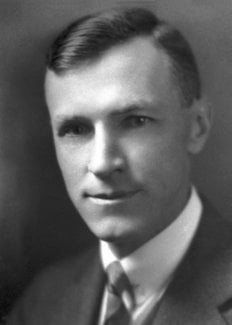William P. Murphy
Biographical

William Parry Murphy was born on February 6, 1892, at Stoughton Wisconsin, U.S.A. He is the son of Thomas Francis Murphy and Rose Anna Parry, his father being a congregational minister with various pastorates in Wisconsin and Oregon. William Parry was educated at the public schools of Wisconsin and Oregon and at the University of Oregon, where he took his A.B. degree in 1914.
For the next two years he taught physics and mathematics at the high schools of Oregon, and then spent one year at the University of Oregon Medical School at Portland, where he also acted as a laboratory assistant in the Department of Anatomy. He then attended a summer course at the Rush Medical School in Chicago and was later awarded the William Stanislaus Murphy Fellowship at Harvard Medical School, Boston. He held this Fellowship for three years and graduated as a Doctor of Medicine in 1922.
Two years as House Officer at the Rhode Island Hospital followed and he then became Assistant Resident Physician at the Peter Bent Brigham Hospital under Professor Henry A. Christian. This appointment he held for eighteen months and then he was appointed Junior Associate in Medicine at this hospital.
In 1924 he was appointed Assistant in Medicine at Harvard, and from 1928 until 1935 he was Instructor in Medicine there. From 1935 until 1938 he was Associate in Medicine at Harvard and from 1948 until 1958 Lecturer in Medicine, becoming in 1958 Senior Associate in Medicine, and subsequently Emeritus Lecturer in that subject.
In 1923 Murphy practised medicine for a time and subsequently engaged in research on diabetes mellitus and on diseases of the blood. Murphy’s work on pernicious and other forms of anaemia was outstanding. For the treatment of pernicious and hypochromic anaemia and for granulocytopenia he used intramuscular injections of extract of liver and he was associated with George Richards Minot and George Hoyt Whipple in work on pernicious anaemia and the treatment of it by means of a diet of uncooked liver. For this work he was awarded, together with George Richards Minot and George Hoyt Whipple, the Nobel Prize for Physiology or Medicine for 1934. He wrote Anemia in Practice: Pernicious Anemia (1939).
He has been consulting haematologist to several hospitals, and he now lives at Brooklyn, Mass., U.S.A. Among his many distinctions and honours are the Cameron Prize of the University of Edinburgh, together with George Richards Minot for their work on pernicious anaemia (1930), the Bronze Medal of the American Medical Association for an exhibit demonstrating his methods of treating anaemias with liver extract (1934), the First Rank of Decoration-Commander of the Order of the White Rose, Finland (1934), and the National Order of Merit, Carlos J. Finlay, Official, Cuba (1952).
He is member of numerous medical and allied societies at home and abroad, including the Deutsche Akademie der Naturforscher Leopoldina.
Murphy married Pearl Harriett Adams on September 10, 1919, and they have one son, Dr. William P. Murphy, Jr. Their only daughter, Priscilla Adams, died in 1936.
This autobiography/biography was written at the time of the award and first published in the book series Les Prix Nobel. It was later edited and republished in Nobel Lectures. To cite this document, always state the source as shown above.
William P. Murphy died on October 9, 1987.
Nobel Prizes and laureates
Six prizes were awarded for achievements that have conferred the greatest benefit to humankind. The 12 laureates' work and discoveries range from proteins' structures and machine learning to fighting for a world free of nuclear weapons.
See them all presented here.
